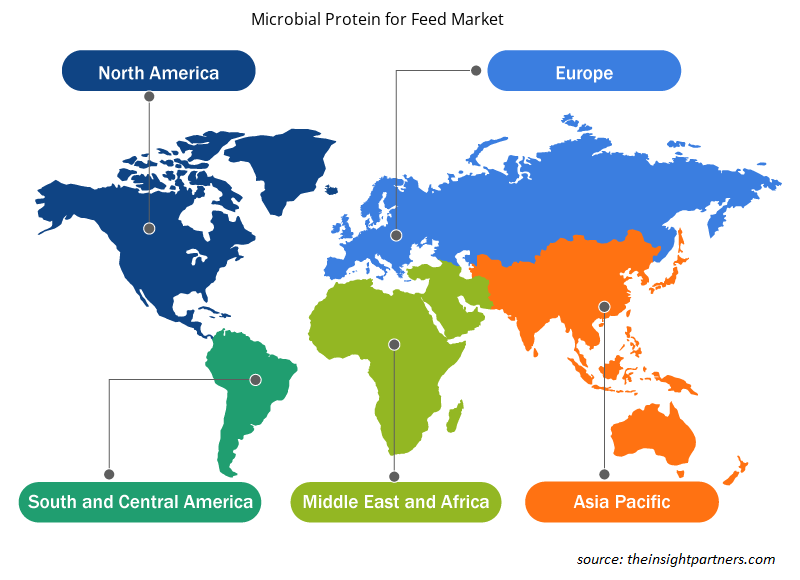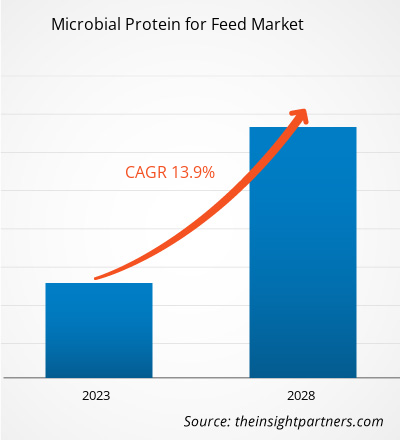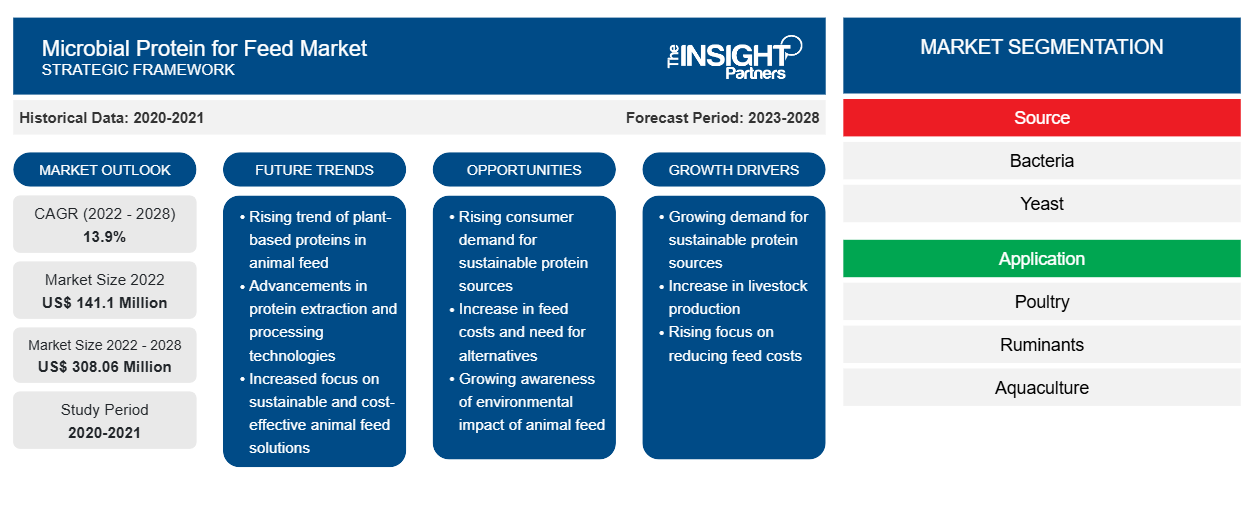Der Markt für mikrobielle Proteine für Futtermittel soll von 141.095,88.000 US-Dollar im Jahr 2022 auf 308.055,17.000 US-Dollar im Jahr 2028 wachsen; für den Zeitraum von 2022 bis 2028 wird eine durchschnittliche jährliche Wachstumsrate (CAGR) von 13,9 % erwartet.
Mikrobielles Protein ist eine der wichtigsten Rohproteinquellen. Die Zugabe von mikrobiellem Protein zu Tierfutter bietet viele ernährungsphysiologische Vorteile . Mikrobielles Protein enthält mehr als 70 % Rohprotein, während Sojamehl 40–50 % und Fischmehl 60–65 % Rohprotein enthält. Darüber hinaus weist es ein ideales Aminosäureprofil auf, einschließlich höherer Anteile an Valin, Tryptophan, Isoleucin und Leucin als Fischmehl. Mikrobielles Protein ist eine hervorragende Alternative zu herkömmlichen Proteinquellen wie Sojabohnen und Fischmehl. Es wird aus kostengünstigen Substraten wie Industriegasen (Kohlendioxid, Methan und Erdgas), Abwasser und Geflügelabfällen (Federn) hergestellt, die in einem Reaktor mit Bakterien, Hefen, Pilzen oder Mikroalgen fermentiert werden. Die verschiedenen ernährungsphysiologischen Vorteile der Zugabe von mikrobiellem Protein zur Tierernährung und die zunehmenden Nachhaltigkeitsbedenken treiben das Wachstum des Marktes für mikrobielles Protein für Futtermittel voran .
Im Jahr 2021 hatte Europa den größten Anteil am globalen Markt für mikrobielles Protein für Futtermittel. Laut dem Verband der europäischen Futtermittelhersteller (FEFAC) stieg die Schweinefutterproduktion im Jahr 2020 um 2,9 %, trotz der anhaltenden Ausbreitung der Afrikanischen Schweinepest (ASF) in der Region und ihrer Auswirkungen auf die Schweinezucht. Mehrere europäische Länder steigerten ihre Exporte nach China und profitierten vom deutschen Exportverbot, das 2020 zu einem Anstieg der Schweinefutterproduktion führte. Angesichts der steigenden Tierfutterproduktion suchen die Hersteller nach nachhaltigen Futterzusätzen, da Futterzusätze tierischen und pflanzlichen Ursprungs heutzutage nicht als umweltfreundlich angesehen werden. Importierte Futtermittel wie Soja bedrohen natürliche Ressourcen und die Artenvielfalt. Daher steigt die Nachfrage der Tierfutterhersteller nach mikrobiellem Protein.
Passen Sie diesen Bericht Ihren Anforderungen an
Sie erhalten kostenlose Anpassungen an jedem Bericht, einschließlich Teilen dieses Berichts oder einer Analyse auf Länderebene, eines Excel-Datenpakets sowie tolle Angebote und Rabatte für Start-ups und Universitäten.
-
Holen Sie sich die wichtigsten Markttrends aus diesem Bericht.Dieses KOSTENLOSE Beispiel umfasst eine Datenanalyse von Markttrends bis hin zu Schätzungen und Prognosen.
Auswirkungen der COVID-19-Pandemie auf den Markt für mikrobielle Proteine für Futtermittel
Die Futtermittelindustrie stand vor entscheidenden Herausforderungen wie einem Mangel an Rohstoffen und Arbeitskräften, einem Anstieg der Rohstoffpreise und Störungen der Vertriebsnetze aufgrund von Lockdowns, Reiseverboten, Handelsbeschränkungen, Fabrikschließungen und anderen staatlich verhängten Beschränkungen auf der ganzen Welt. Dies behinderte die Produktionsaktivitäten verschiedener Unternehmen der Tierfutterindustrie und führte in der Folge zu höheren Preisen für Futterzutaten. In der Europäischen Union wiesen etwa zwei Drittel der Mitgliedstaaten auf den Anstieg der Futtermittelpreise in der Viehwirtschaft während der Pandemie hin. Darüber hinaus schloss China auf dem Höhepunkt der Pandemie in den meisten Regionen den Handel mit Vieh und Geflügel sowie die Schlachtmärkte. Solche Barrieren in der Viehwirtschaft behinderten die Nachfrage nach Futterzutaten, was sich während der Pandemie negativ auf die Nachfrage nach mikrobiellem Protein für Futtermittel auswirkte.
Im Jahr 2021 nahmen viele Volkswirtschaften ihre Produktion wieder auf, nachdem ihre Regierungen Lockerungen der zuvor verhängten Beschränkungen ankündigten, was dem globalen Markt Auftrieb gab. Darüber hinaus durften die Hersteller mit voller Kapazität arbeiten, was ihnen half, die Lücke zwischen Angebot und Nachfrage sowie andere Auswirkungen zu überwinden.
Markteinblicke
Staatliche und private Investitionen werden sich positiv auf das Wachstum des Marktes für mikrobielle Proteine für Futtermittel auswirken
Der Klimawandel und die Übernutzung natürlicher Ressourcen wie Land und Wasser sind die größten Nachhaltigkeitsprobleme in der Viehzucht- und Tierfutterindustrie. Daher finanzieren Regierungen verschiedener Länder auf der ganzen Welt Unternehmen, die Tierfutter und -zutaten unter Verwendung nachhaltiger Verfahren herstellen, um ihren gesamten CO2-Fußabdruck zu reduzieren und das Wachstum der Kreislaufwirtschaft zu unterstützen. Regierungen und private Investoren unterstützen auch Unternehmen, die Tierfutterprotein aus Mikroorganismen herstellen, da dies eine der nachhaltigsten Proteinquellen für die Tierernährung ist. So erhielt beispielsweise Arbiom – ein französisch-amerikanischer Hersteller hochwertiger Proteine für Tierfutter und Lebensmittelanwendungen durch die Verarbeitung landwirtschaftlicher Abfälle und Holzrückstände – im Februar 2022 eine Investition von 13,50 Millionen US-Dollar aus dem Investitionsprogramm France Relance. Nach Erhalt der Investition kündigte das Unternehmen den Bau seiner ersten kommerziellen Produktionsanlage in Frankreich an. Daher wird erwartet, dass sich die steigenden staatlichen und privaten Investitionen in den Markt für mikrobielle Proteine für Futtermittel im Prognosezeitraum positiv auf das Marktwachstum auswirken werden.
Quelle Einblicke
Basierend auf der Quelle ist der globale Markt für mikrobielles Protein für Futtermittel in Bakterien, Hefe und andere unterteilt. Das Bakteriensegment hielt 2021 den größten Anteil am globalen Markt für mikrobielles Protein für Futtermittel und wird voraussichtlich von 2022 bis 2028 die höchste CAGR verzeichnen. Bakterien weisen im Vergleich zu Hefe und anderen Mikroorganismen die höchsten Wachstumsraten auf. Darüber hinaus ist die Menge an Protein, die durch Bakterienkulturen produziert wird, die größte. Darüber hinaus besteht es aus mehr als 70 % Rohprotein und weist ein günstiges Profil essentieller Aminosäuren auf. Laut verschiedenen Studien produzieren 1.000 kg Bakterien eine höhere Proteinqualität als Sojabohnen und Rinder. Somit sind Bakterien eine der kostengünstigsten und schnellsten Proteinquellen für Tierfutter. All diese Faktoren treiben den Markt für dieses Segment an.
Zu den wichtigsten Akteuren auf dem globalen Markt für mikrobielle Proteine für Futtermittel zählen Calysta, Inc., Avecom, Arbiom, KnipBio, ICC und Alltech. Die Marktteilnehmer konzentrieren sich darauf, qualitativ hochwertige Produkte anzubieten, um die Kundennachfrage zu erfüllen. Sie konzentrieren sich auch auf Strategien wie Investitionen in Forschungs- und Entwicklungsaktivitäten, Partnerschaften und Expansion.
Mikrobielles Protein in Futtermitteln
Mikrobielle Proteine für Futtermittel – regionale Einblicke
Die regionalen Trends und Faktoren, die den Markt für mikrobielle Proteine für Futtermittel im Prognosezeitraum beeinflussen, wurden von den Analysten von Insight Partners ausführlich erläutert. In diesem Abschnitt werden auch die Marktsegmente und die Geografie für mikrobielle Proteine für Futtermittel in Nordamerika, Europa, im asiatisch-pazifischen Raum, im Nahen Osten und Afrika sowie in Süd- und Mittelamerika erörtert.

- Erhalten Sie regionale Daten zum Markt für mikrobielle Proteine für Futtermittel
Umfang des Marktberichts über mikrobielle Proteine für Futtermittel
| Berichtsattribut | Details |
|---|---|
| Marktgröße im Jahr 2022 | 141,1 Millionen US-Dollar |
| Marktgröße bis 2028 | 308,06 Millionen US-Dollar |
| Globale CAGR (2022 - 2028) | 13,9 % |
| Historische Daten | 2020-2021 |
| Prognosezeitraum | 2023–2028 |
| Abgedeckte Segmente |
Nach Quelle
|
| Abgedeckte Regionen und Länder |
Nordamerika
|
| Marktführer und wichtige Unternehmensprofile |
|
Dichte der Marktteilnehmer für mikrobielle Proteine für Futtermittel: Auswirkungen auf die Geschäftsdynamik verstehen
Der Markt für mikrobielle Proteine für Futtermittel wächst rasant, angetrieben durch die steigende Nachfrage der Endverbraucher aufgrund von Faktoren wie sich entwickelnden Verbraucherpräferenzen, technologischen Fortschritten und einem größeren Bewusstsein für die Vorteile des Produkts. Mit steigender Nachfrage erweitern Unternehmen ihr Angebot, entwickeln Innovationen, um die Bedürfnisse der Verbraucher zu erfüllen, und nutzen neue Trends, was das Marktwachstum weiter ankurbelt.
Die Marktteilnehmerdichte bezieht sich auf die Verteilung von Firmen oder Unternehmen, die in einem bestimmten Markt oder einer bestimmten Branche tätig sind. Sie gibt an, wie viele Wettbewerber (Marktteilnehmer) in einem bestimmten Marktraum im Verhältnis zu seiner Größe oder seinem gesamten Marktwert präsent sind.
Die wichtigsten Unternehmen auf dem Markt für mikrobielle Proteine für Futtermittel sind:
- CALYSTA INC.
- Avecom
- Arbiom
- KnipBio
- ICC
Haftungsausschluss : Die oben aufgeführten Unternehmen sind nicht in einer bestimmten Reihenfolge aufgeführt.

- Überblick über die wichtigsten Akteure auf dem Markt für mikrobielle Proteine für Futtermittel
Wichtige Entwicklungen:
Im Juni 2022 gründeten Calysta Inc. und Adisseo das Joint Venture „Calysseo“, um ihre erste Produktionsanlage im industriellen Maßstab in Chongqing, China, zu eröffnen. Dort sollen jährlich 20.000 Tonnen FeedKind, ein mikrobielles Protein für Aquafutter, produziert werden. Nach der erfolgreichen Produktion und dem Vertrieb von FeedKind in China planen die Joint-Venture-Partner, die Produktionskapazität in den kommenden Jahren auf 80.000 Tonnen pro Jahr zu erhöhen.
Bericht-Spotlights
- Fortschrittliche Branchentrends im Markt für mikrobielle Proteine für Futtermittel helfen den Akteuren bei der Entwicklung wirksamer langfristiger Strategien
- Von Industrie- und Entwicklungsländern übernommene Strategien für Unternehmenswachstum
- Quantitative Analyse des Marktes für mikrobielle Proteine für Futtermittel von 2020 bis 2028
- Schätzung des weltweiten Bedarfs an mikrobiellem Protein für Futtermittel
- PEST-Analyse zur Veranschaulichung der politischen, wirtschaftlichen, sozialen und technologischen Faktoren, die sich auf das Wachstum des globalen Marktes für mikrobielle Proteine für Futtermittel auswirken.
- Aktuelle Entwicklungen zum Verständnis des wettbewerbsorientierten Marktszenarios
- Markttrends und -aussichten sowie Faktoren, die das Wachstum des Marktes für mikrobielle Proteine für Futtermittel vorantreiben und bremsen
- Unterstützung im Entscheidungsprozess durch Aufzeigen von Marktstrategien, die das kommerzielle Interesse untermauern und zum Marktwachstum führen
- Marktgröße für Selbstbräunungsprodukte an verschiedenen Knotenpunkten
- Detaillierte Übersicht und Segmentierung des Marktes sowie der mikrobiellen Proteindynamik für die Futtermittelindustrie
- Größe des Marktes für mikrobielle Proteine für Futtermittel in verschiedenen Regionen mit vielversprechenden Wachstumschancen
- Historische Analyse (2 Jahre), Basisjahr, Prognose (7 Jahre) mit CAGR
- PEST- und SWOT-Analyse
- Marktgröße Wert/Volumen – Global, Regional, Land
- Branchen- und Wettbewerbslandschaft
- Excel-Datensatz
Aktuelle Berichte
Verwandte Berichte
Erfahrungsberichte
Grund zum Kauf
- Fundierte Entscheidungsfindung
- Marktdynamik verstehen
- Wettbewerbsanalyse
- Kundeneinblicke
- Marktprognosen
- Risikominimierung
- Strategische Planung
- Investitionsbegründung
- Identifizierung neuer Märkte
- Verbesserung von Marketingstrategien
- Steigerung der Betriebseffizienz
- Anpassung an regulatorische Trends























 Kostenlose Probe anfordern für - Mikrobielles Protein für den Futtermittelmarkt
Kostenlose Probe anfordern für - Mikrobielles Protein für den Futtermittelmarkt